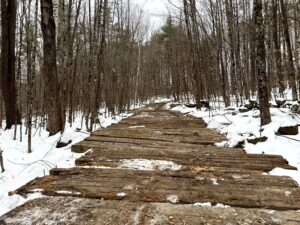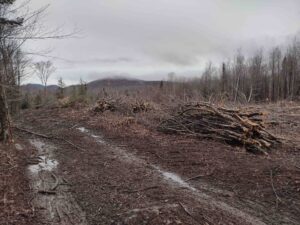Innovations in Education
Extreme Weather BMPs
By Andy Fast

Innovation captures our attention with breakthrough technologies – computerized log processing, wooden skyscrapers, or medical treatment using cellulose nanofibers. However, the overwhelming majority of innovations are incremental. It may be imperceptible if not looking closely, but small innovations compile and synergize. The advancements sneak up on the user. The recipient of the technology thinks we do this better than we used to, but I cannot tell you exactly when it changed. Best Management Practices (BMPs) for water and soil protection are a great example of incremental innovation – evolving approaches and practices over time that meet changes in society, regulations, and climate.
Origins
With their origins in the early and mid-1900s, largely through federal agency soil and watershed protection research, they were codified after the 1972 Clean Water Act when states were directed to develop voluntary state BMP programs to address potential sources of nonpoint source pollution. While BMPs are established or accepted by regulators, the practices often originate with, and are improved by, logging contractors.

The genesis of Extreme Weather BMPs began three or four decades ago in response to rapid weather fluctuations and associated flooding in steep western slopes. Contractors had to start thinking about their approach differently and address the conditions that they were experiencing. Over the subsequent decades, BMPs were imperceptibly influenced by climate change and “getting ahead” of potential issues on site.
Both formal data from researchers and public agencies, as well as anecdotal observations from logging contractors indicate logging conditions have changed, and traditional logging seasons are less predictable. From an operational perspective logging contractors were experiencing this before many others. Like always, when operating conditions changed, they had to come up with solutions – good, bad, or indifferent. These responses informed technical guide modifications and new recommendations. While BMPs were well established, practitioners asked themselves: What can be done at the extremes?
Extreme Weather BMPs in the Northeast
The first instances I saw acknowledging the need for new, adaptive, BMPs was a UNH Extension Field Note titled “Emergency Erosion Control Techniques for Dealing with Severe Weather Conditions During an Active Timber Harvest.”
Karen Bennett and Jim Frohn authored the publication, but a dozen other foresters and loggers were contributors, and the USDA Forest Service funded the work through the Landscape Scale Restoration Program and the NH Timberland Owners Association, NH Division of Forests and Lands were collaborators in the work.
The publication was impactful. It addressed planning and demonstrated creative emergency BMPs that help protect soil and water during extreme weather events. Examples include using straw waddles, logs, and salt to create and define channels to move water off roads and trails. There were demonstrations of “hitches in ditches,” brush mats, and hardened landings. While these are in the family of traditional BMPs, the novelty came in expanding functionality when needed.
Moreover, it launched a decade of additional outreach, disseminating these sometimes modest but innovative practices to minimize soil disturbance and protect water during extreme weather.
There were steady New Hampshire Professional Logger Program extreme BMP workshops for logger contractors in NH, and regular presentations and field tours with foresters. These practices and discussions were extended to New Hampshire Division of Foresters and Lands foresters, introduced at state lands’ buyer meetings, and relayed through the USDA Forest Service’s “Rooted in Research” webinars. A particularly exceptional and memorable presentation was from Steve Roberge and Keith Kanoti during the New England Society of American Foresters meeting in 2022. The concepts and outreach were not limited to New Hampshire, with organizations such as the Professional Logging Contractors of the Northeast conducting regional Extreme BMP programs as well.
Foresters and logging contractors continued making small, but noticeable changes in harvest planning because it made sense for them to do it. The BMP workshops were excellent opportunities to pull information together and share lessons learned, but the most meaningful outcome was a foundational shift for some contractors to ensure there is not unnecessary lost time and expense repairing skid and truck roads. UNH Extension Forester Steve Roberge reflects on changes he has noticed. “The best BMP is planning. A number of foresters and logging contractors internalized this need for planning. When visiting their jobs, they show added operational resilience in the face of increasing unpredictable and extreme weather.”

There is no one right way to plan BMPs, weather uncertainty and layout, and there are numerous approaches along an operational gradient. John Whyte of Whyte’s Logging states it well. “We don’t wait for the weather anymore. We get ahead of it. If there is any potential site issue, we are stockpiling material and installing brush mats, corduroy, timber mats – whatever is required.” Others do not preinstall the BMPs in anticipation of needs, but more deliberately build their slash infrastructure and use their “just in time” inventory to address issues when they crop up in identified areas. Fewer logging contractors are waiting for significant problems to occur before installing remedial measures.
Current practice reflects an iterative feedback loop. The Forest Service started requiring contractors to consider climate change on timber sales in the 2010s. These kinds of influences, no doubt contributed to logging contractors refining their practices both formally and informally. The work they continue to do informs additional guidance and planning documents such as the excellent publication titled Climate Change Considerations for Forest Operations in Northern Forests by Toot et al. in 2025.
What is next?
There continues to be interesting and incremental innovations around BMPs.
The Natural Resource Conservation Service’s core mission is related to soil and water protection. They have contributed to permanently closing out eroding trails and roads, as well as installing skidder bridges to protect wetland resources and water quality on private land. There is interest from the NRCS to use BMPs in new ways to protect soil and water, and formalize new practices if those practices have demonstrated effectiveness.
Research led by Steve Roberge and Alix Contasta and funded by the Northeastern States Research Cooperative is looking at how mats and preemptive BMP installation affects soil temperatures and frost to better understand how and when operating conditions can be extended.
Stalwarts like Jim Frohn, Ray Berthiaume, Cheri Birch and others continue logger training related to extreme BMPs in New Hampshire with similar efforts in other states and the region.
All these efforts work in concert with practitioners in the field. BMPs will continue to evolve as foresters and logging contractors innovate. Goals have not changed: Slow water so sediment drops; Get water above grade so rutting is minimized and there is less erosion; Use temporary measures to protect soil during the harvest and close-out the sale properly.
It will likely be hard to tell the exact moment when practices improve again. However, in the future, like now, there may be a few more foresters and logging contractors who opt to hold off operating in poor conditions. There may be a bit more slash pre-piled along skid roads, or some mats on the landing. There may be a few more contractors with formal or informal BMP plans rather than just meeting minimum wetlands regulatory requirements, or there may be some new products or practices to protect soil and water. One thing is for sure – as conditions change, practices will change with them.
Authors note: The author would like to recognize and acknowledge the logging contractors and foresters who have shared their insights and practices to the “extreme BMP” publications and workshops over the last decade, as well as Steve Roberge’s sustained leadership, effort, and commitment to “Extreme BMP” educational efforts over that period.
To subscribe to The Northern Logger, go to https://www.northernlogger.com/magazine-preview/
